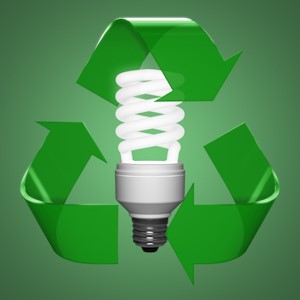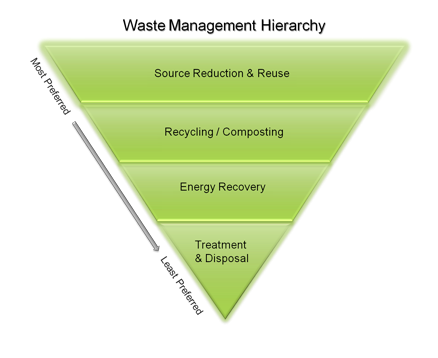
EPA
The use of energy-efficient compact fluorescent lamps (CFLs) to replace incandescent bulbs is recommended by the US EPA because they ironically prevent mercury from entering our air. While CFLs contain a small amount of mercury as an essential ingredient, the largest source of mercury emissions in the US comes from coal-fired power plants to produce electricity.
Here’s the reasoning: a CFL uses 75% less energy than an incandescent bulb and lasts six to ten times longer. Over five years, a power plant will emit 10mg of mercury to produce the electricity to run an incandescent bulb, compared to only 2.4mg of mercury to run a CFL for the same time. Combined with the 4.0mg of mercury contained in the CFL itself, lighting using incandescent bulbs is responsible for emitting a third more mercury into the environment.
In fact, according to a recent report by the Earth Policy Institute, a worldwide shift to CFLs would permit the closing of more than 270 coal-fired power plants. Switching to CFLs in the US alone could save the energy output of 80 plants.
QUICK FACT:
Relative Household Mercury Amounts
CFL–4mg
4-foot fluorescent lamp–8mg
Mercury thermometer–500mg
Automotive mercury switch–800mg
Older Thermostat–3000mg (Source: NMED)
A battery is used in almost every device that needs electrical energy to run. They come in many sizes, from miniature cells used to power hearing aids and wristwatches to battery banks the size of rooms that provide standby power for telephone exchanges and computer data centers.
The majority of devices are cordless, but other types of batteries can be plugged in to be recharged.
Battery recycling reduces resources required for manufacture of new batteries and diverts heavy metals and toxic chemicals from our landfill. Batteries, when not handled or disposed of properly can pose an environmental concern like toxic metal pollution. Many battery chemicals are corrosive, poisonous, or both and can be harmful or fatal if swallowed.
The 3 main types of batteries:
1. AUTOMOTIVE / CAR BATTERIES
Lead Acid Batteries
Commonly found in cars, golf carts, industrial fork-lifts, motorcycles, and as commercial batteries. These can be regular lead acid, sealed lead acid, or gel type.
Toxic! Please handle with care.
Where can I take it?
BuRRT Fridays and Saturdays 8:00 a.m. – 4:45 p.m.
CALL FIRST TO CHECK WITH COMPANIES OUTSIDE THE AGENCY. WE REGULARLY UPDATE INFORMATION; HOWEVER, WITH A CONSTANTLY CHANGING INDUSTRY AND PROCESSES, TOO, THINGS CAN CHANGE AT ANY TIME.
Capital Scrap Metals Inc. – Car batteries ONLY
1162 Cooks Lane, Santa Fe, New Mexico
(505) 471-0740
Mr. G’s Recycling – Car batteries ONLY
7625 Baca Lane, Santa Fe, New Mexico
(505) 474-6969
2. RECHARGEABLE BATTERIES
Rechargeable battery use is overall easier on the pocket book and has less of an environmental impact than disposable batteries. The Lithium Ion Battery is the most common type of rechargeable battery used in the home or office as it is found in most portable electronics like your phone or laptop.
HOW TO PREPARE: When you drop off rechargeable batteries, please make sure the ends are TAPED with traditional ‘scotch’ tape. If possible, please place larger batteries with their ends taped into a plastic bag before dropping off. If you drop these types of batteries off at BuRRT, they can go to the HHW Collection Center which is open Fridays and Saturdays 8:00 a.m. – 4:45 p.m.
Lithium-Ion Batteries (Li-ion or LIB)
The most popular rechargeable battery; commonly found in most portable electronics.
Nickel-Cadmium Batteries (NiCd or NiCad)
Commonly found in portable electronics, remote-controlled electric toys, as well as cordless power tools and camera flash units.
Toxic! Please handle with care and do not incinerate.
Nickel Metal Hydride Batteries (NiMH)
This was the most common type of rechargeable battery until the increased production of Li-ion Batteries. Commonly found in toys, tools , and hybrid cars.
3. NON-RECHARGEABLE BATTERIES
Non-rechargeable batteries are also known as single use or disposable batteries which were designed to be used once and discarded. Most non-rechargeable are Alkaline Batteries in the standard sizes of AAA, AA, C-cell, D-Cell, buttons and 9 volts.
Other batteries consist of:
Alkaline & Carbon Zinc Batteries – THESE ARE NOT ACCEPTED AT BuRRT
Alkaline batteries account for 80% of manufactured batteries in the US and over 10 billion individual units produced worldwide. The everyday household batteries used in flashlights, remote controls, and other appliances are currently legal to dispose of in the regular garbage in every state, aside from California. California passed a series of laws called the California Universal Waste Rules that require these batteries to be recycled. Several reclamation companies now process these batteries. Everywhere else, single use batteries can be disposed of in the trash. Consider rechargeable batteries next time. (Source)
Lithium Batteries
Not to be confused with Lithium Ion Batteries. Commonly used in portable electronic devices.
Mercury Batteries
Sale of mercury batteries is banned in many countries. Commonly used in medical devices, calculators and military applications.
Silver-Oxide Batteries
Commonly used in watches, hearing aids, and aircraft.
Zinc Air Batteries
Commonly used in hearing aids, film cameras to electric vehicle propulsion.
Where can I take it?
BuRRT Fridays and Saturdays 8:00 a.m. – 4:45 p.m.

